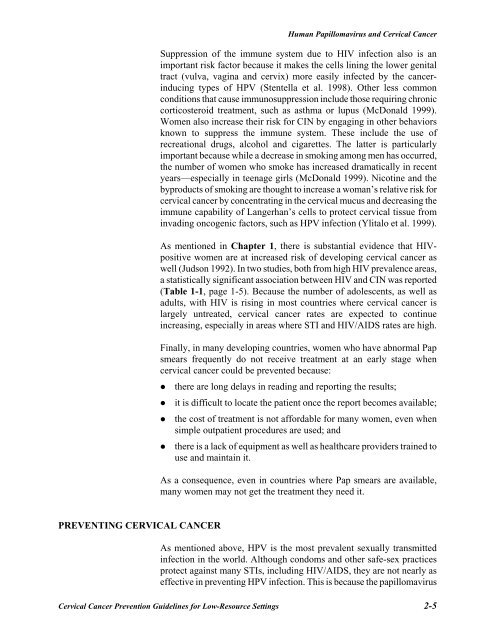Reference Manual - IARC Screening Group
Reference Manual - IARC Screening Group
Reference Manual - IARC Screening Group
Create successful ePaper yourself
Turn your PDF publications into a flip-book with our unique Google optimized e-Paper software.
Human Papillomavirus and Cervical CancerSuppression of the immune system due to HIV infection also is animportant risk factor because it makes the cells lining the lower genitaltract (vulva, vagina and cervix) more easily infected by the cancerinducingtypes of HPV (Stentella et al. 1998). Other less commonconditions that cause immunosuppression include those requiring chroniccorticosteroid treatment, such as asthma or lupus (McDonald 1999).Women also increase their risk for CIN by engaging in other behaviorsknown to suppress the immune system. These include the use ofrecreational drugs, alcohol and cigarettes. The latter is particularlyimportant because while a decrease in smoking among men has occurred,the number of women who smoke has increased dramatically in recentyears—especially in teenage girls (McDonald 1999). Nicotine and thebyproducts of smoking are thought to increase a woman’s relative risk forcervical cancer by concentrating in the cervical mucus and decreasing theimmune capability of Langerhan’s cells to protect cervical tissue frominvading oncogenic factors, such as HPV infection (Ylitalo et al. 1999).As mentioned in Chapter 1, there is substantial evidence that HIVpositivewomen are at increased risk of developing cervical cancer aswell (Judson 1992). In two studies, both from high HIV prevalence areas,a statistically significant association between HIV and CIN was reported(Table 1-1, page 1-5). Because the number of adolescents, as well asadults, with HIV is rising in most countries where cervical cancer islargely untreated, cervical cancer rates are expected to continueincreasing, especially in areas where STI and HIV/AIDS rates are high.Finally, in many developing countries, women who have abnormal Papsmears frequently do not receive treatment at an early stage whencervical cancer could be prevented because:• there are long delays in reading and reporting the results;• it is difficult to locate the patient once the report becomes available;• the cost of treatment is not affordable for many women, even whensimple outpatient procedures are used; and• there is a lack of equipment as well as healthcare providers trained touse and maintain it.As a consequence, even in countries where Pap smears are available,many women may not get the treatment they need it.PREVENTING CERVICAL CANCERAs mentioned above, HPV is the most prevalent sexually transmittedinfection in the world. Although condoms and other safe-sex practicesprotect against many STIs, including HIV/AIDS, they are not nearly aseffective in preventing HPV infection. This is because the papillomavirusCervical Cancer Prevention Guidelines for Low-Resource Settings 2-5
















